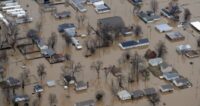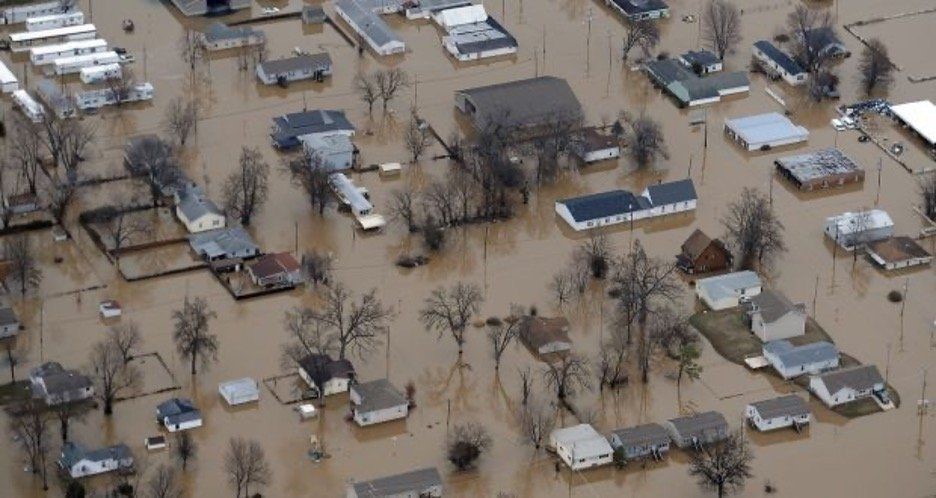2022 TOP 10 BLOG
The National Flood Insurance Program and the Growing Cost of Natural Disasters in the Era of Climate Change
VJEL Staff Editor: Cameron Briggs Ramos
Faculty Member: John Echeverria

Introduction
Accelerating climate change due to the accumulation of greenhouse gases in the atmosphere magnifies both the severity and financial costs of natural disasters, particularly flooding. This trend poses a major challenge for the National Flood Insurance Program, a U.S. government program designed to ensure that citizens gain access to the flood insurance they need and can afford while also reducing the vulnerability of properties and communities to flooding over the long-term. In the year ahead, it will be interesting to watch the Biden administration’s effort to perform this difficult balancing act with the launch of the new “Risk Rating 2.0” program.
The Rising Tide of Disasters
Higher global temperatures are being reflected in warmer ocean waters, which in turn are increasing the frequency and severity of storm events. Climate change also increases precipitation variability in general, with more rainfall occurring in fewer, high-intensity events. Increased rates of precipitation, in particular in the Midwest and Eastern United States, are projected to lead to more frequent and more severe flooding in the years ahead.
In coastal areas, rising sea levels exacerbate the vulnerability of individual homes and communities to severe storms and flooding attributable to climate change. The National Oceanic and Atmospheric Administration (NOAA) that global sea level rose 0.14 inches per year between 2006 and 2015 and that in 2020 global sea level reached 3.6 inches above the level in 1993. Eastern coastline communities face a 400%–1,100% increase in hightide flooding days due to the rise in global sea level. Storm surges building on top of these high tides pose a particular threat to these coastal communities, which comprises 40% of the total population in the contiguous United States.
The United States is already experiencing more severe—and more costly— storm events. In 2020, there was a record-breaking number of 22 natural disasters in the United States, inflicting a total cost of $99 billion. In 2021, 18 separate climate disasters have occurred, with 4 of these events being catastrophic hurricanes and tropical storms. While the number of events this year has not superseded those in 2020, the cost of these separate disasters has already surpassed the costs of the 2020 disasters. So far in 2021, post-disaster costs have amounted to $104.8 billion. Two of the costliest storms in the United States over the last decade were Superstorm Sandy in 2012 and Hurricane Harvey in 2017. The World Meteorological Organization estimated that economic losses inflicted by Superstorm Sandy totaled $54.47 billion and $96.94 billion for Hurricane Harvey.
In accord with these estimates of the overall costs of recent storms, the number and size of insurance claims filed under the National Flood Insurance program have increased dramatically. In recent years, the cost of insurance payouts has greatly exceeded the amount received in insurance premiums. As a result, FEMA has accumulated a debt to the U.S. Treasury of over $20 billion as of 2021, despite Congress having canceled $16 billion in previous FEMA debt in October 2017.
The NFIP Framework
Congress created the National Flood Insurance Program in 1968 based on the perception that private insurers were unable and/or unwilling to offer policy coverage to owners of flood-prone properties. At the same time, conscious even then of the rising costs of disaster relief, Congress sought to use the “carrot” of federally-backed insurance to induce property owners and local governments to improve resilience in the face of flood risk and thereby lower federal disaster relief costs in the long run. The program, including determinations of insurance costs, is managed by the Federal Emergency Management Agency (FEMA), which oversees a network of approximately 50 private insurance companies that directly market insurance policies to the public. FEMA prepares and periodically updates flood maps that delineate coastal and riverine areas subject to the risk of flooding and help homeowners understand the risk of flooding. While participation in the NFIP is voluntary, flood insurance is generally required if a person wishes to secure a mortgage to purchase a structure in a mapped floodplain.
Some critics of the NFIP have argued that FEMA has not set insurance rates at a high enough level to reflect the risk associated with occupying flood-prone land or to allow the federal government to cover the costs of payouts under the flood insurance policies. In 2012, in response to these concerns, and with strong support from many environmentalists and advocates of “free market” solutions to environmental problems, Congress enacted the Biggert-Waters Flood Insurance Reform Act, which directed FEMA to raise insurance rates to actuarially sound levels. This legislation quickly generated a firestorm of political protests from coastal property owners who faced very rapidly escalating insurance premiums. In addition, critics of the legislation contended that the steep increases in premiums placed a particularly severe and unfair burden on low- and moderate-income families.
In response to these concerns, in 2014, Congress adopted the Homeowner Flood Insurance Affordability Act (HFIAA), which rolled back most of the major provisions of the 2012 legislation. The HFIAA extended grandparented rates to certain long-established flood plain uses and directed FEMA to create an affordability framework to ensure that flood insurance remained affordable.
Over the ensuing years, Congress has engaged in an extended debate over how to accomplish a comprehensive reform of the NFIP to make the program financially self-sustaining, resolve the affordability problem, and address the new challenges posed by the increased risk of flooding due to climate change. So far, these efforts have come to naught. Since 2017, Congress has enacted 17 stop-gap reauthorizations of the NFIP, and the next deadline for reauthorization is looming on December 3, 2021.
Looking Forward
In the absence of comprehensive legislative reform, the Biden administration is currently focusing on improving agency implementation of the existing NFIP. In response to the Homeowner Flood Insurance Affordability Act’s mandate to FEMA to create an “affordability framework,” in 2018, FEMA published “An Affordability Framework for the National Flood Insurance Program” with three elements: (1) improving communication to policyholders and potential NFIP participants; (2) developing targeted assistance to policyholders based on their financial status; and (3) examining community work that mitigates flood insurance costs. To carry out the goal of assisting low-and-moderate income families, the “Build Back Better” agenda currently before Congress proposes spending $208 million to assist low-income individuals in purchasing flood insurance and an additional $150 million to help low-income individuals implement flood risk mitigation plans.
The Biden administration is also in the process of rolling out a new NFIP risk-assessment initiative labeled “Risk Rating 2.0.” The Risk Rating 2.0 assessment relies on new technology to assess relative flood risk based on a number of variables such as flood frequency, possible flood types, and property characteristics. Relevant property characteristics include the property’s distance to water, the property’s elevation, and the cost of rebuilding the property. The hope is that this intensive analysis of risk factors will generate premium rates that more accurately and fairly reflect flood risks at different locations. At the same time, the Risk Rating 2.0 initiative recognizes the potential impacts of rate increases on families and will work within the current statutory requirement that premium increases do not surpass 18% per year. In addition, premium discounts will be offered to policyholders in communities participating in the Community Rating System, which encourages communities to adopt effective community floodplain management practices to mitigate flood risks. Premiums discounts will also be offered to policyholders who implement mitigation tools on their properties, such as elevating structures. Rates generated by the Risk Rating 2.0 Initiative applied to new policies starting on October 1, 2021 and will apply to remaining policies being renewed on or after April 1, 2022.
Whether these initiatives will effectively make insurance more widely available, encourage insurance rates that are sounder from an actuarial perspective, and help contain long-term disaster relief costs remains to be seen. As climate-related natural disasters become more frequent, the need for the federal government to support opportunities for individual property owners and communities to build resilience will become ever more critical.

